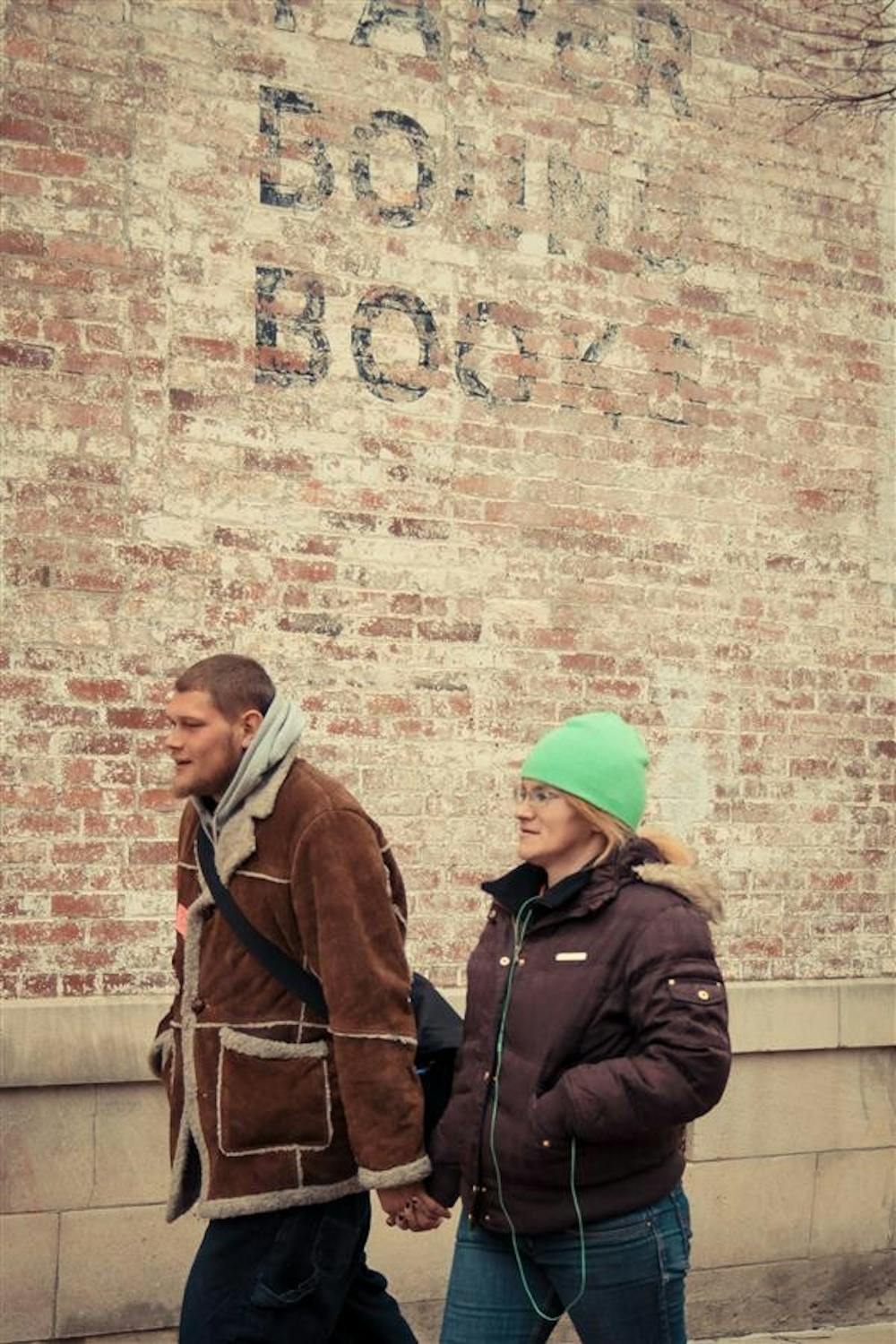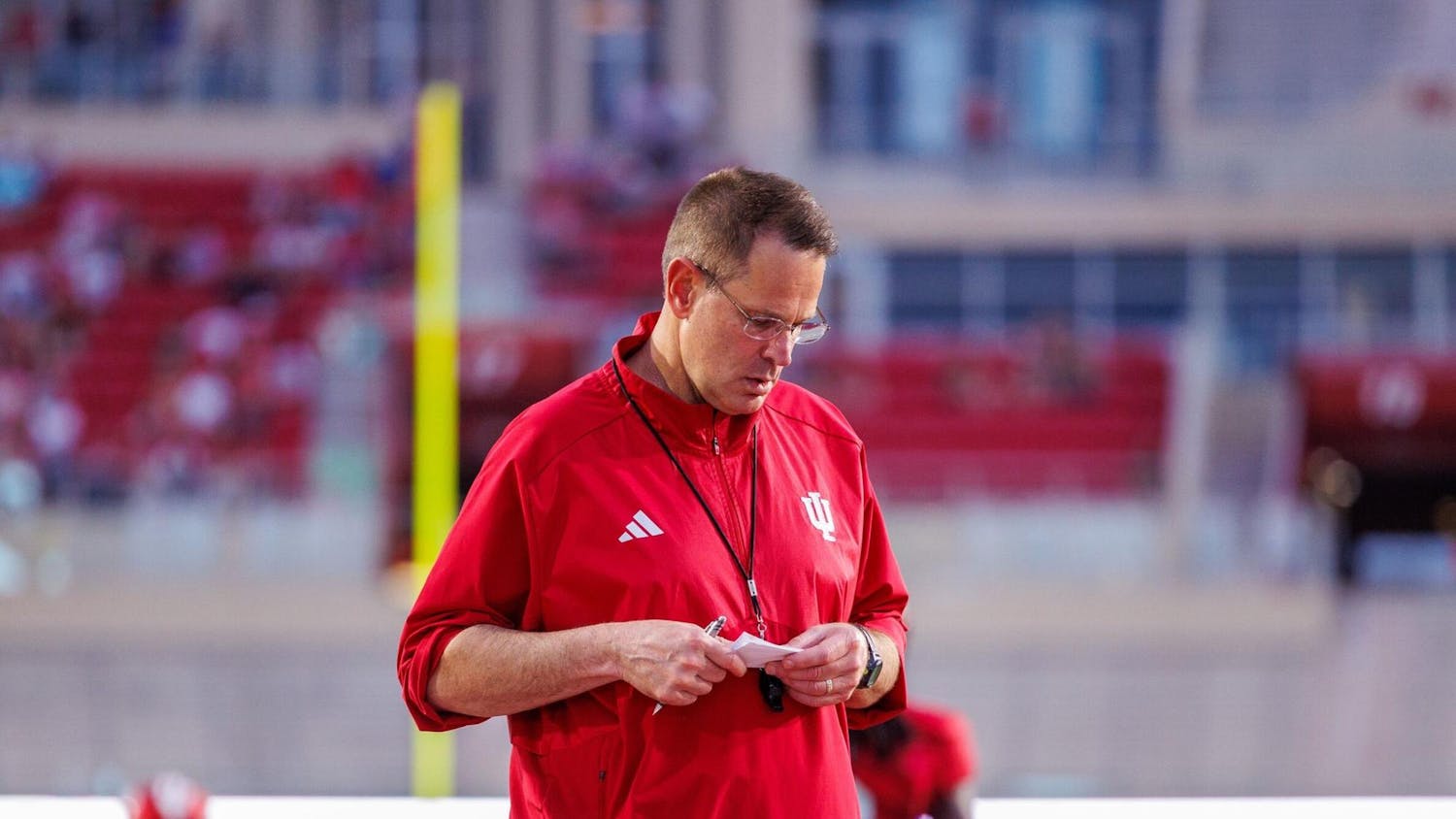Women were first in line. One man slumped against a handrail, head down, not moving. Two others were singing “Hotel California” by the Eagles. One square, white light illuminated the alley, casting shadows across the pavement.
Angela Riley got to the line early, like always. She wanted to secure her bed spot.
She was waiting with about 40 others at 9 p.m. Friday in the alley behind the First Christian Church for the Interfaith Winter Shelter to open.
Fifty is max capacity, the site director said as he closed the door. A man cursed at him, holding rolled up blankets and bags.
They’ve been hitting full capacity a lot lately, the site director said.
The winter shelter will close today and not open again until October 31. With no summer shelter to replace it, its 50-some tenants will be sleeping on the streets.
***
Interfaith is the only low-barrier overnight shelter in Bloomington. Other shelters such as Martha’s House, Backstreet Missions and New Hope Family Shelter are open year-round but require residents be sober Monroe County citizens with no history of sexual crimes.
The only requirement at Interfaith is respectful behavior. The shelter is open from 9 p.m. to 6 a.m. and moves between four churches each night. First United Church,
First Christian Church, First United Methodist Church and Trinity Episcopal Church are the sites for the shelter, but other churches in Bloomington contribute to funding.
Samantha Harrell, who directed Interfaith on Sundays, worked every day this winter to find a summer shelter.
She hated having to tell people she was “working on it” or that they were “having meetings,” because she didn’t want to sound bureaucratic.
At meetings Harrell wore a shy, humble smile. She waited for everyone to voice their opinions and concerns before speaking.
But sometimes, while talking one-on-one, she got carried away with explanations. Logistics, charitable policies, budgets, zoning laws. Closed doors.
Her explanations built on each other in an effort to connect the dots of an issue with so many complexities. But there was one question Harrell couldn’t answer.
Why was no one stepping up?
“It’s just this crisis that doesn’t feel like a crisis,” she said. “It’s everyone’s responsibility to address homelessness.”
She knew she would likely end up passing out blankets and food at night once the shelter closed, like last year.
Many residents had become her friends, and she didn’t want to let them down. Riley, or Stephanie or Buzzsaw, who earned his nickname because he sounds like a buzzsaw when he snores.
“Shelter is a right, not a privilege,” she said.
The tattoo on her arm says, “Because your liberation is bound up in mine.”
***
Angela Riley tries to straighten her hair every day because she doesn’t like how it frizzes. She’ll plug her straightener into an outlet at the Shalom Community Center lounge and flat iron it without a mirror.
She smokes cigarettes because they helped her overcome her meth addiction. She calls her children almost every day. Angela holds these consistencies dear.
She writes to-do lists and reminders in her planner, because right now her hobby is trying to better her life. At 29, she’s experienced homelessness off and on for four years.
“I don’t want to be homeless in 30 years,” Angela said. “The longer you’re homeless, the less you’re encouraged to do something about it.”
Keeping focused on her goals — getting a job, applying for rapid rehousing,
being able to see her kids grow up — helps her say no to the substance that used to rule her life.
Meth used to help her stay awake so she wouldn’t have to sleep on the streets, she said. It made the pain go away.
But now, if she remembers her to-do list, she can say no to meth.
***
Harrell, the Sunday site director at Interfaith, grew up with parents who struggled with addiction, and she watched her mom slip in and out of homelessness. She realized the only reason she turned out differently was her good fortune, the lifelines people threw her.
The teachers who took her out to lunch, the people who gave her free books, one sibling she looked up to — they made the difference. She knew others didn’t have that support.
“There are people who are addicted to drugs that have houses,” Harrell said. “There are people with mental illnesses that have houses. There are people with criminal histories that have houses. Homelessness is not created by individuals.”
When she started volunteering at Interfaith five years ago, she said, she couldn’t help but be reminded of her family.
She felt more at home at Interfaith. When she attended IU as an undergrad, she wasn’t used to being around so many middle-class people.
She would overhear phone calls of Interfaith residents talking to their kids, crying, trying to explain why they weren’t there and why they couldn’t hug them or hold them or go to their school performances.
Witnessing that, she said, prompted her to call her own mother, who she hadn’t spoken to in almost two years.
She knew she was where she was supposed to be.
***
A woman walked toward the women’s sleeping room at 10:30 p.m., the scheduled bedtime. Her boyfriend followed. He kissed her goodbye, then got on his knees and kissed her pregnant stomach.
“Got to kiss the baby, too,” Angela said, watching.
The women’s room had a warm glow to it, lit by a small lamp. 11 mats were each labeled with pink duct tape — the same duct tape used to label the lamps and tables and markers.
An ornate clock sits atop an unused, Victorian-style fireplace. The only thing on the walls is a painting of an important-looking man with white hair hung next to the window. A bookcase is stacked with red leather Bibles.
The first time she was in jail Angela read the entire Bible. She didn’t sleep at all those first two weeks, she said. That was seven years ago.
The mats are numbered and about two inches thick. There are 11 for the women and 49 for the men. The men sleep in a bigger room across the hall, but they still let Angela say goodnight to her boyfriend before bedtime.
Angela always sleeps in the same bed at First United. It’s the one with the fuzzy pink blanket, labeled number 10.
Each tenant gets a mat to sleep on and a fuzzy blanket, but hers is the comfiest. She always sleeps next to her best friend, Missy.
“Every night at every shelter we put our beds next to each other,” she said.
You get used to sleeping in a room with a bunch of people, Angela said. You get used to all the snoring and coughing and shuffling.
***
“Smoke break,” Angela yelled to the room of people. They get one at night and one in the morning.
Angela is always the one yelling. She knows she’s a loudmouth, but sometimes you have to be, she said.
The day before she was born, Angela’s mom went speed boating. Angela likes to say all the bumps from the waves are what made her this way.
“I love you,” Angela yelled at Deckard as he went back inside the shelter after finishing his cigarette. They were both chewing on chopsticks left over from their takeout.
Everyone knows Angela at the shelter. She’s the homeless representative for Shalom Community Center, which provides showers, laundry services and a daytime shelter for the homeless.
She’s taken to being the voice of the tenants.
“We love you, Cliff,” Angela yelled at a man with a catatonic expression who was being taken out on a stretcher.
The altercation was not dramatic. It happens a couple times a week, Angela said. Someone gets too high or too drunk or is having breathing problems, and the volunteers decide they need to go to the hospital.
“Make sure you tell them we’ll call,” she yelled at him as he was carried down the stairs.
***
A man approached the empty volunteer desk, reeking of alcohol, confused about which mat he was assigned to. Angela, who was nearby, looked down the list and told him he was bed number 19, not 20.
“I’m the unofficial Interfaith volunteer,” she said.
It has been Angela’s dream to become a social worker. She was inspired by a volunteer at Shalom Community Center.
“For some crazy reason my ass wants to help people,” she said.
Angela recently re-enrolled in Ivy Tech Community College. After she gets her school ID and schedules her classes, she’s ready to start working on her human services degree. She applied for financial aid and every scholarship possible, she said.
She plans to attend classes in May, but because Interfaith is closed, she will be sleeping on the streets.
She wants to get a place of her own so she can have her three kids visit. Her two sons and youngest daughter live with her ex-husband.
“They know mommy sleeps in a church every night,” she said.
Her daughter, who she calls “mini-me,” inherited her spunk. She is 5 years old and not afraid to boss her older brothers around.
“She’s evil just like me,” Angela said, smiling.
When Angela appeared in the Bloomington Herald-Times after receiving her GED, her son’s teacher gave him a copy of the article.
He framed it.
***
Harrell will deliver care packages of blankets and food to Interfaith tenants tonight, just like she did last summer. She will help lead a candle-lit vigil to raise awareness about the shelter’s closing.
She wonders how Angela will do tonight. Harrell is amazed by her resilience, and she thought that somehow Angela would figure something out. But she hasn’t.
Not yet.
Harrell says she wishes she could make people understand everyone has worth.
“We have not gotten away from the idea of deserving and undeserving poor,” Harrell said. “You shouldn’t have to be a good enough person to survive.”
Angela said she planned on pursuing options with relatives, but she knew there were no guarantees. She didn’t know where she would sleep tonight.
She may be finding shelter in alleyways, dumpsters and the undersides of porches.
Maybe she’ll return to the window frame of the County Courthouse, where she willed herself to sleep most nights last summer. She’ll try to shake off the fear that someone will beat her up and take her things.
At least it’s not the bare ground, she tells herself. She can’t stand not knowing what she’s lying on. Maybe old urine. Maybe vomit. She never could get used to the dirt.
It feels to her like the winter — when the cold stokes the public’s compassion and the shelter opens its doors — is the only time she matters.
“Nobody cares about us in the summer,” she says.
Summer, for her, starts tonight.
----------------------------------------------
Summer Shelter Alternatives
Interfaith Winter Shelter director Samantha Harrell and the supporters of the opening of a summer shelter have said finding a space big enough and willing to house about 60 people every night in their low price range has been challenging. The process of meeting with zoning officials and city planners would likely take months to complete, if successful.Here are some alternatives Harrell and other supporters have explored to house people experiencing homelessness.
City-owned Buildings
Bloomington Mayor Mark Kruzan has clearly said he does not support the summer shelter and believes the homeless population in Bloomington is mostly a migrated one. “Police and social service providers are seeing more people coming to town, often saying they've done so based on word of mouth that there are many services available here,” he said in an email. Service providers are already struggling to meet local need, so it's unsustainable to have more people coming here solely for services.Harrell said Kruzan’s lack of support has made it hard to pursue options under the city’s jurisdiction, such as vacant lots, empty city-owned buildings, and parks and recreation properties that have potential to serve as a temporary shelter. Harrell and others have also pursued the County Council but were referred back to the city.
Public Camping
Many people experiencing homelessness last year resorted to public camping. However, public camping is illegal in the City of Bloomington, and was tolerated in previous years because it was considered a form of protest, or was on private property. New construction during the past decade has wiped out many hidden camping locations,such as parts of what is now the B-Line Trail.
Place of Worship
Harrell said many churches support their mission to find a summer shelter, but none are willing to off er their own spaces. Churches that are host to Interfaith from November through March cite volunteer burnout as a reason to deny the shelter request. Other institutions said they had inadequate space or unsupportive congregations.
Seeking shelter
Interfaith Winter Shelter closes tonight, leaving people on the streets

Get stories like this in your inbox
Subscribe





